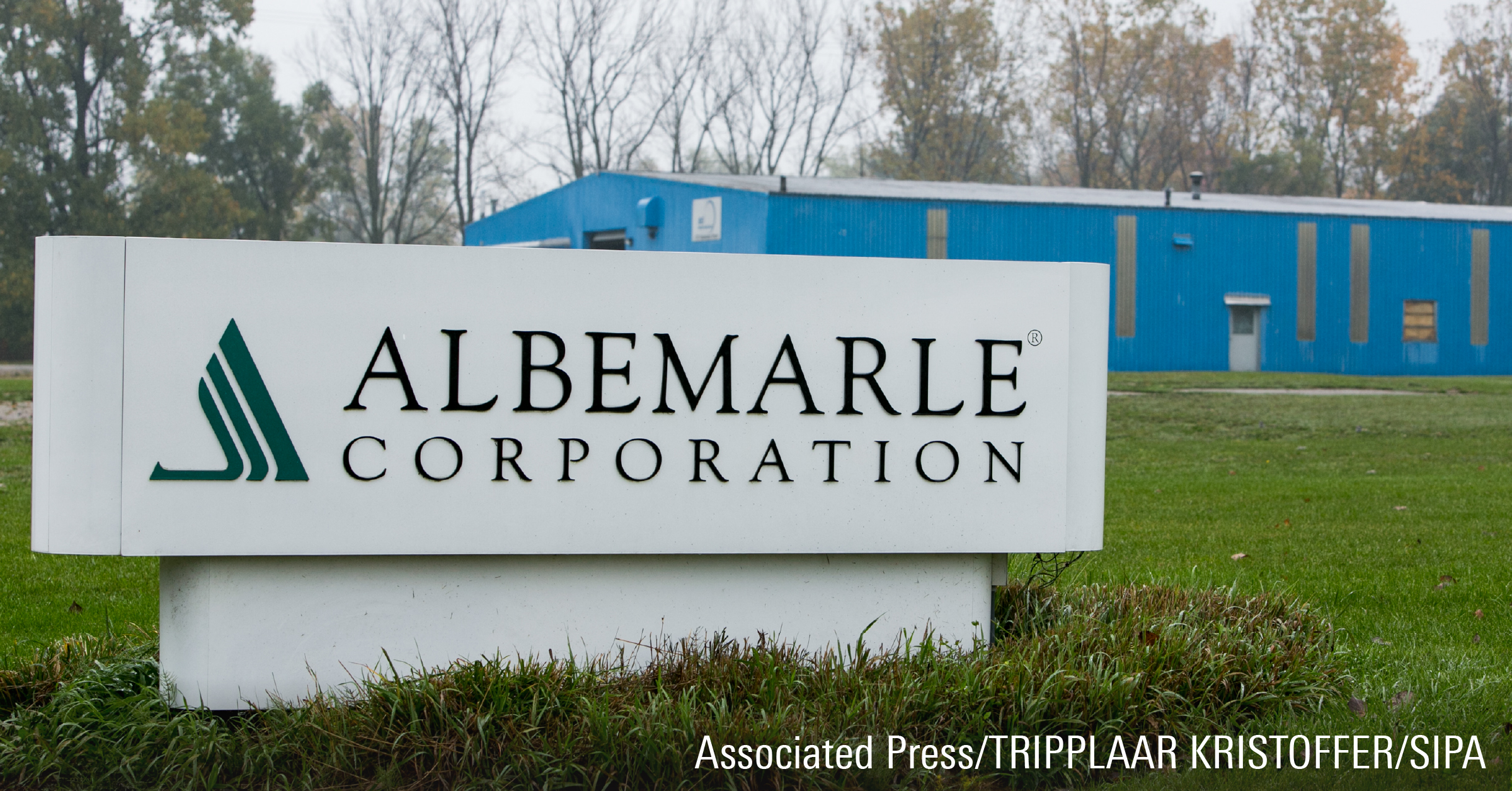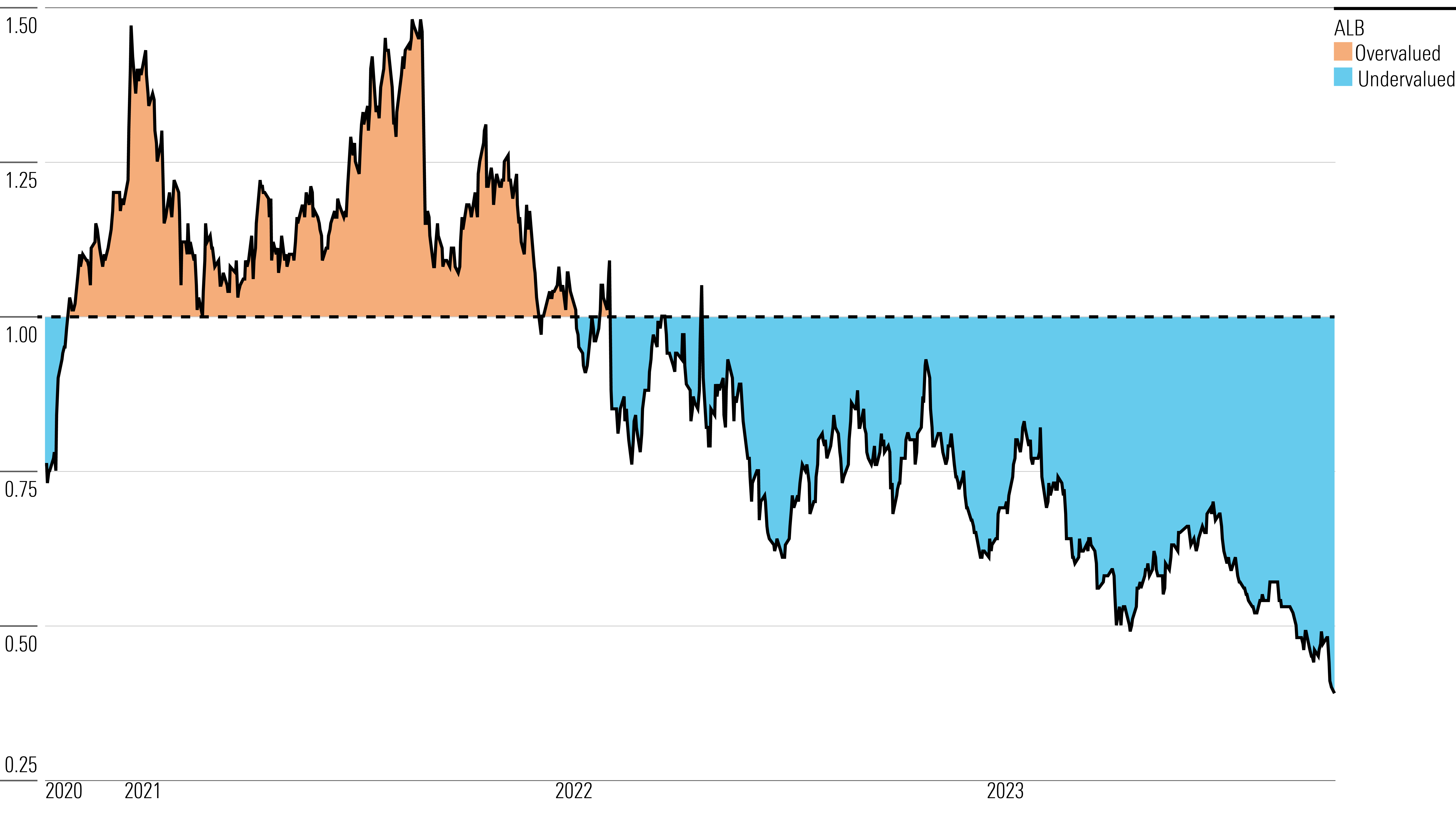Going Into Earnings, Is Albemarle Stock a Buy, a Sell, or Fairly Valued?
With lithium pricing uncertain, here’s what we think of Albemarle stock.

Albemarle ALB stock is down 49% over the last 12 months. Ahead of its third-quarter earnings report, here is Morningstar’s take on what to look for in Albemarle’s earnings and the outlook for its stock.
Key Morningstar Metrics for Albemarle
- Fair Value Estimate: $350.00
- Morningstar Rating: 5 stars
- Morningstar Economic Moat Rating: Narrow
- Morningstar Uncertainty Rating: High
Albemarle Earnings Date
Nov. 1, after the market close.
What to Watch for In Albemarle’s Q3 Earnings
- Realized lithium prices: Lithium spot prices fell in the third quarter but stabilized in October. There are an increasing number of bearish calls for prices to fall further, which has weighed on the stock in recent days. We will be listening for the company’s realized price changes in the third quarter (Albermarle does not report prices), as well as its pricing guidance for the fourth quarter and 2024. The company’s index-referenced pricing should be less volatile than spot prices but still move in the same direction over time.
- Investment strategy: Albemarle recently walked away from a proposed acquisition of a junior lithium concentrate producer, Liontown Resources LINRF. We are hoping to hear how the company is thinking about future acquisitions or its strategy for capacity growth.
- Lithium demand: We are hearing a somewhat bearish outlook from some downstream customers, including electric vehicle model delays and slowing growth from major battery producers. We want to hear the company’s outlook for lithium demand in the near term and learn whether it has changed since the strategic update in January.
Albemarle Stock Price
Fair Value Estimate for Albemarle
With its 5-star rating, we believe Albemarle’s stock is undervalued compared with our long-term fair value estimate.
Our fair value estimate is $350 per share. We assume roughly a 10% weighted average cost of capital. We use a multiple of 11.5 times midcycle EBITDA to value free cash flows generated beyond our 10-year explicit forecast horizon.
Our price forecast is based on our forecast for the marginal cost of lithium production on an all-in-maintaining cost basis. We expect lithium demand to grow at nearly a 20% annual rate from around 800,000 metric tons in 2022 to over 2.5 million metric tons by 2030. By 2030, roughly 95% of lithium demand will come from batteries that require high-quality lithium with few impurities. To meet demand, higher-cost supply will need to come online from lower-quality resources that will require higher processing costs.
We forecast Albemarle’s lithium capacity will grow to nearly 600,000 metric tons during the next decade and benefit from strong demand growth. The firm’s low costs should let it benefit tremendously from additional volume sold. Higher prices and volumes will help Albemarle’s energy storage EBITDA more than double from 2022 levels by 2030, even with lower lithium prices versus the $70,000 per metric ton average index price in 2022.
Read more about Albemarle’s fair value estimate.
Albemarle Historical Price/Fair Value Ratio

Economic Moat Rating
We assign Albemarle a narrow economic moat, based on its cost advantage and switching costs.
Albemarle possesses the lowest-cost sources of lithium and bromine production. It also benefits from switching costs in its catalyst business, where refiners and petrochemical producers tend to stick with existing catalysts tailored to their facilities to maximize product yields.
Globally, lithium carbonate is produced from either the lower-cost evaporation of brine or the higher-cost mining of spodumene minerals. Albemarle has a cost advantage in lithium carbonate production due to its lucrative brine assets in the Salar de Atacama in Chile.
The company benefits from switching costs in refining catalysts, which are tailored to specific refineries to maximize customer profits. Refiners are essentially a commodity spread business, earning profits by converting crude oil into refined end products, including gasoline and diesel. These catalysts make up a small portion of a refiner’s costs and are priced based on the value they contribute to customers through improving yields, quality, and output. Catalysts provide value to refiners far in excess of their cost. Albemarle, W.R. Grace, and BASF make up the majority of the FCC catalyst market. Existing catalyst providers hold the advantage of being able to tweak their catalyst over time and maintain customer relationships, as catalyst suppliers continually improve refiner economics.
Read more about Albemarle’s moat rating.
Risk and Uncertainty
We assign Albemarle a High Morningstar Uncertainty Rating.
The biggest risk for Albemarle is volatile lithium prices. Prices could decline if EV demand grows more slowly than expected. New batteries, such as sodium-ion, could overtake lithium as the preferred energy storage resource.
Albemarle faces execution risks in ramping up its lithium production, including production delays and cost overruns. Albemarle is also subject to political risk, especially in Chile. President Gabriel Boric announced a plan to nationalize lithium whereby the government would own a majority stake in all projects. If this occurs, Albemarle could be forced to sell a 51% stake to the Chilean government at a price as low as asset book value to extend its lease when it expires in 2043.
The largest ESG risks come from potential new regulations. Regulations that limit emissions in the bromine business could hurt profit margins, as Albemarle’s profits come from its cost advantage rather than pricing power, and it may not be able to pass along the cost increases. We see this as having a moderate probability and materiality.
Read more about Albemarle’s risk and uncertainty.
ALB Bulls Say
- Albemarle has top-tier lithium assets through its brine operations in Chile and spodumene hard-rock operations in Western Australia, which are among the lowest-cost sources of lithium production globally.
- Lithium prices will remain well above the marginal cost of production through at least the remainder of the decade, leading to excess profits and return on invested capital for Albemarle.
- Albemarle has low-cost bromine production through its highly concentrated brines in the Dead Sea and Arkansas.
ALB Bears Say
- Lithium prices will fall as new supply comes online faster than demand, which will weigh on profitability. Albemarle’s plans to increase its lithium production capacity will prove value-destructive in the wake of lower prices.
- Albemarle’s bromine business will decline from weak demand for flame retardants as consumers shift from computers to less bromine-intensive tablets and smartphones.
- The Chilean government’s plan to nationalize lithium could result in Albemarle being forced to sell a majority stake to the government at a price around asset book value, destroying shareholder value.
This article was compiled by Brendan Donahue.
The author or authors do not own shares in any securities mentioned in this article. Find out about Morningstar’s editorial policies.

/s3.amazonaws.com/arc-authors/morningstar/ca8d2ce1-cd0f-433b-a52b-d163be882398.jpg)
/cloudfront-us-east-1.images.arcpublishing.com/morningstar/PVJSLSCNFRF7DGSEJSCWXZHDFQ.jpg)
/cloudfront-us-east-1.images.arcpublishing.com/morningstar/F5UMFVVKMVFRPGGUY4LONIK6OY.jpg)
/d10o6nnig0wrdw.cloudfront.net/05-03-2024/t_8ba91080cb4d43acae9d9119875abede_name_file_960x540_1600_v4_.jpg)
:quality(80)/s3.amazonaws.com/arc-authors/morningstar/ca8d2ce1-cd0f-433b-a52b-d163be882398.jpg)